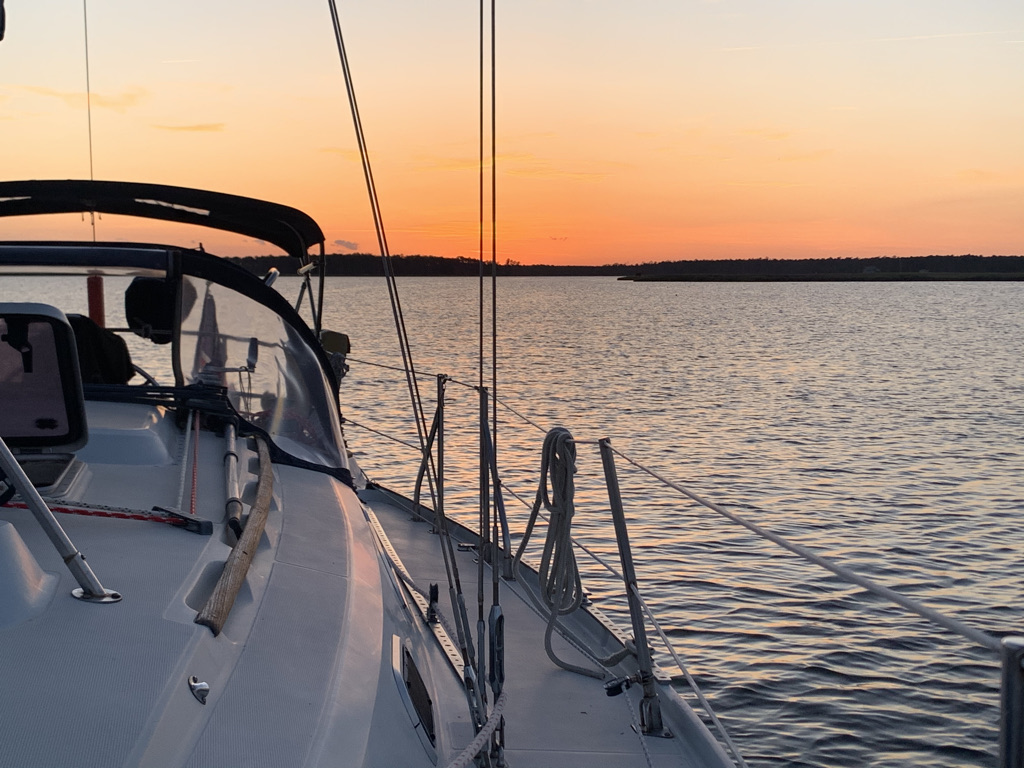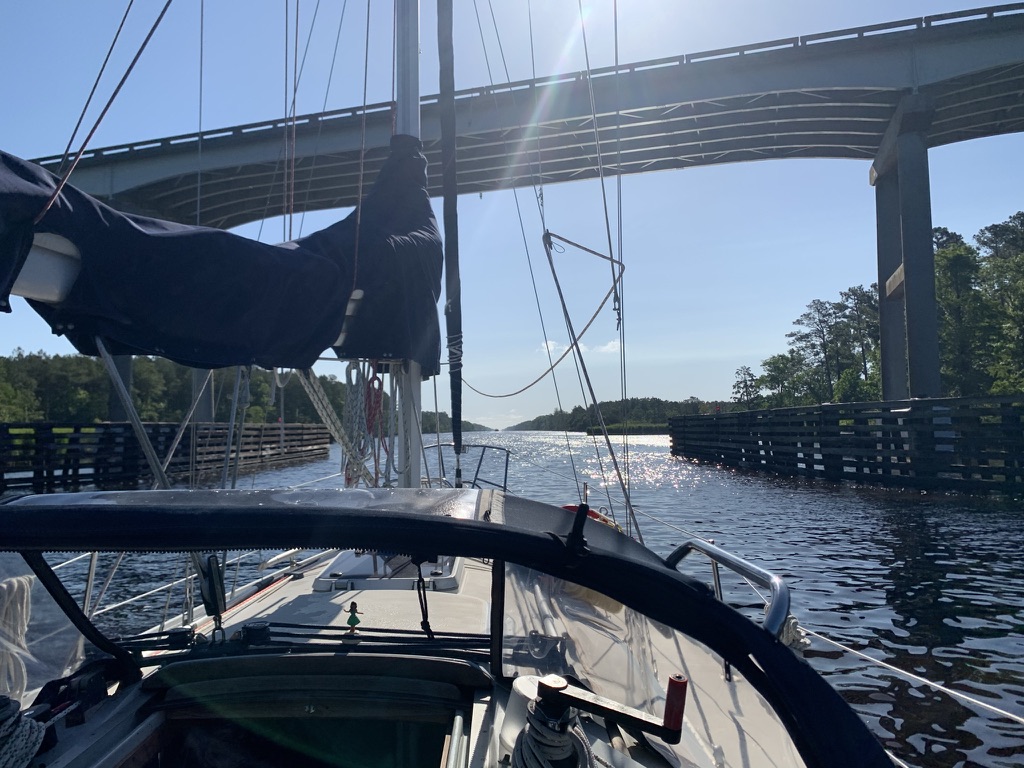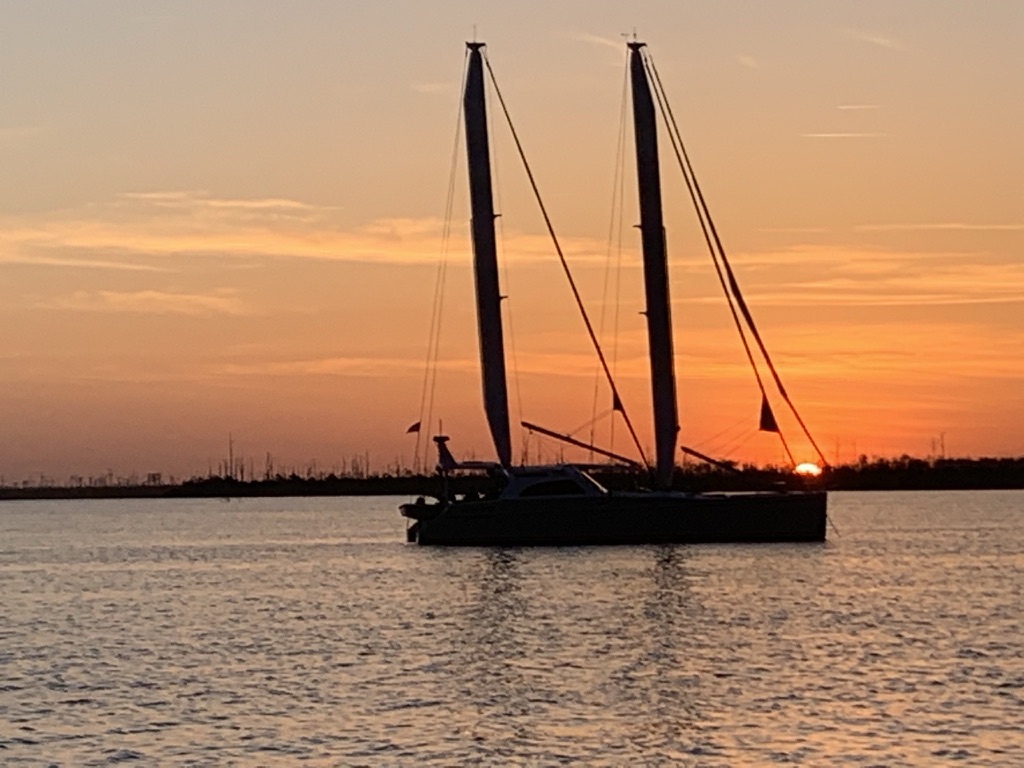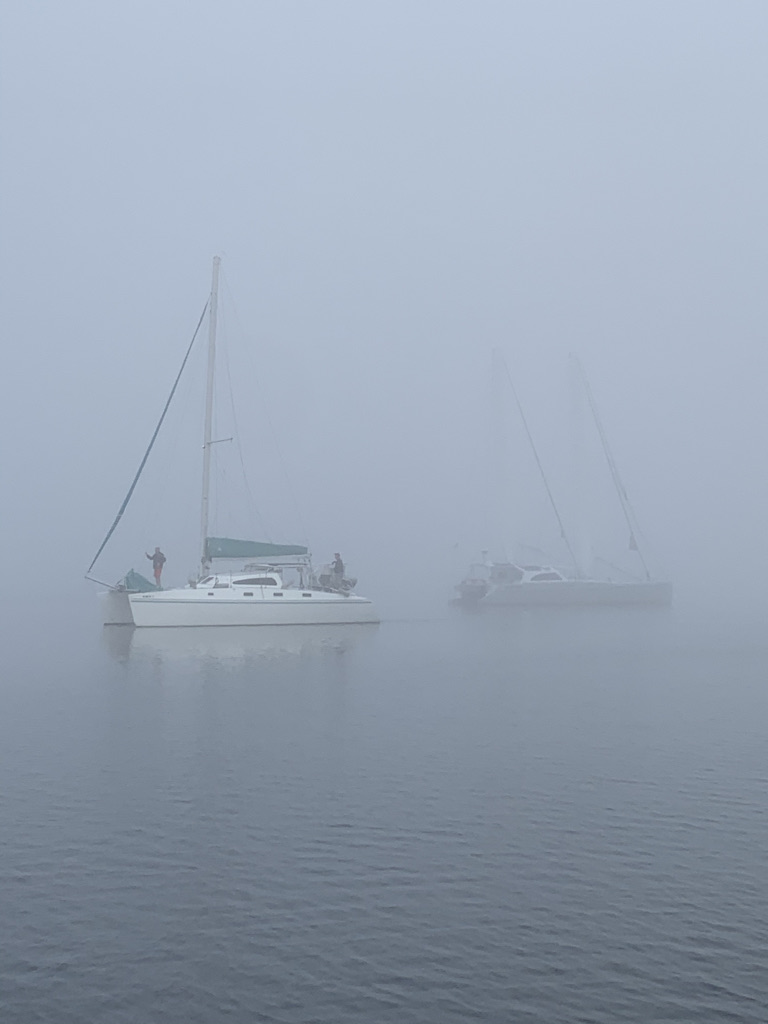jtsai
Member III
In summer 2021, I gave myself a retirement present to explore the Chesapeake Bay. A supposedly month-long trip turned into a 6 month stay at the Stingray Point Marina in Deltaville, VA. I did not sail further north than St. Marys City, MD at the northern shore of the Potomac River. Some of the more popular sailing/tourist spots such as Solomons Island, Annapolis, and St. Michaels will be explored in the future.
This was my first long distance solo cruising trip. I spent 40 days on the water (not consecutively), traveled 640 nautical miles, accumulated 135 engine hours, and lost 5 pounds (the most expensive diet plan?).
Ardea is a 1990 Ericson 32-3. She is equipped with shoal keel (4’3” draft), spade rudder, Universal 25XP (23 rated HP), 110% roller furling jib, and mainsail with lazy jack lines. She carries a Rocna 15 (33 lbs) anchor, 30’ 5/16” G4 chain and 150’ rode (no windlass, ouch!). The dinghy is an used West Marube inflatable stored in a bag hog-tied at the foredeck when not in tow and is propelled by a 3 hp 2-stroke outboard.
Stop #1: Shakedown trip to Oriental, NC
Ardea is not totally ready for this trip but I slipped away quietly from my home port at the Blackbeard Sailing Club in New Bern, NC. One of the unfinished repairs was a leaky anchor well drain tube. The drain hole is merely 6” from the waterline and the compromised tube allows water in the bilge during choppy conditions. After attempting to repair it twice, I closed the drain hole with quick epoxy from outside until finding a more permanent solution.
I had a nice easy sail to Oriental and tied up at the town dock in front of the Bean’s coffee shop. Many years ago, a few old salts would sit on the Bean’s front porch facing the town dock and raise score cards to rate incoming boaters’ docking maneuvers. They are all probably napping or no longer around.
After sorting and repacking provisions, I discovered water in the bilge. After a courageous “taste test”, it was determined that the source was from a cracked Whaler foot pump housing that kept squirting fresh water when the system is pressurized. I swap it with the salt water pump which I will not use during this trip. I can already tell this trip will require some attitude adjustments. It is true when they say “If you ain’t fixing, it ain’t cruising”.

Stop #2: Eastham Creek off Goose Creek near Pamlico River, NC
The second day we entered the wide open Pamlico Sound, rounded the Maw Point shoal, crossed the Bay River to the section of the Intracoastal Waterway that bisects North Carolina’s low land area.
We found a quiet anchorage at the Eastham Creek among crab pots. It was at this anchorage 10 years ago that some of my so-called “friends” introduced me to the movie “Deliverance”. I have yet to recover from that ordeal.
Had a chat with a fisherman checking his crab pots. He sure has a thick accent, but he probably thought the same about me.

Stop #3: Dowry Creek Marina, Pungo River, Belhaven, NC
Today we crossed the Pamlico River into the Pungo River and stayed at Dowry Creek marina at the mouth of the Alligator River/Pungo River canal. Dowry Creek marina has to be one of the best marinas for the price in North Carolina. They have friendly staff and clean bathrooms with fluffy towels. After my first shower in 3 days, I smelled better and felt better too. No one to impress though.
Despite running the engine during part of the trip, frozen food is thawing out sooner than I can digest. Without solar panels to recharge the batteries and running the refrigerator full time for the third day (draws 4.5 amps), the house bank batteries (pair of Group 31 AGM) are asking for deep charge. Data on energy consumption amperage was one of the things I wanted to collect during this trip before investing in solar panels or upgrade the alternator.
Stop #4: Seeking shelter at the Alligator River/ Pungo River canal, NC
After an uneventful motor trip through the 20 nm Alligator River/Pungo River canal, we were confronted by 20 knots headwinds and 3’ chops in the Alligator River. I was impressed by how well Ardea managed the waves with little fuss; no pounding and sure-footed steering. However, with the engine running at 2,500 RPM I was only able to achieve 3 knots and it will take us 5 hours to reach the next anchorage, well beyond sunset. We turned around and dropped anchor at Bear Point just inside the river entrance. Seven other sailboats joined us later that evening. A big cat with twin wing sails dropped anchor near me.


Stop #5: Camden Bay off North River, north of Albemarle Sound, NC
This morning’s departure from Bear Point was delayed due to thick fog. The sun burned out the fog around 10 am but the wind was a no show. We motored slowly northward in the Alligator River with several boats like ducks.
After being greeted by the friendly Alligator River bridge tender and weaving our way through a thick field of crab pots on the Albemarle Sound, we dropped anchor at Camden Bay early afternoon instead of continuing to Coinjock Marina.
It was a peaceful anchorage until someone started a generator. Oh wait, it was not a generator, it was mayflies swarming. I peered out the companionway and saw every square inch of the cockpit canvas was covered with mayflies. I locked myself in the cabin for the rest of the night.

This was my first long distance solo cruising trip. I spent 40 days on the water (not consecutively), traveled 640 nautical miles, accumulated 135 engine hours, and lost 5 pounds (the most expensive diet plan?).
Ardea is a 1990 Ericson 32-3. She is equipped with shoal keel (4’3” draft), spade rudder, Universal 25XP (23 rated HP), 110% roller furling jib, and mainsail with lazy jack lines. She carries a Rocna 15 (33 lbs) anchor, 30’ 5/16” G4 chain and 150’ rode (no windlass, ouch!). The dinghy is an used West Marube inflatable stored in a bag hog-tied at the foredeck when not in tow and is propelled by a 3 hp 2-stroke outboard.
Stop #1: Shakedown trip to Oriental, NC
Ardea is not totally ready for this trip but I slipped away quietly from my home port at the Blackbeard Sailing Club in New Bern, NC. One of the unfinished repairs was a leaky anchor well drain tube. The drain hole is merely 6” from the waterline and the compromised tube allows water in the bilge during choppy conditions. After attempting to repair it twice, I closed the drain hole with quick epoxy from outside until finding a more permanent solution.
I had a nice easy sail to Oriental and tied up at the town dock in front of the Bean’s coffee shop. Many years ago, a few old salts would sit on the Bean’s front porch facing the town dock and raise score cards to rate incoming boaters’ docking maneuvers. They are all probably napping or no longer around.
After sorting and repacking provisions, I discovered water in the bilge. After a courageous “taste test”, it was determined that the source was from a cracked Whaler foot pump housing that kept squirting fresh water when the system is pressurized. I swap it with the salt water pump which I will not use during this trip. I can already tell this trip will require some attitude adjustments. It is true when they say “If you ain’t fixing, it ain’t cruising”.
Stop #2: Eastham Creek off Goose Creek near Pamlico River, NC
The second day we entered the wide open Pamlico Sound, rounded the Maw Point shoal, crossed the Bay River to the section of the Intracoastal Waterway that bisects North Carolina’s low land area.
We found a quiet anchorage at the Eastham Creek among crab pots. It was at this anchorage 10 years ago that some of my so-called “friends” introduced me to the movie “Deliverance”. I have yet to recover from that ordeal.
Had a chat with a fisherman checking his crab pots. He sure has a thick accent, but he probably thought the same about me.
Stop #3: Dowry Creek Marina, Pungo River, Belhaven, NC
Today we crossed the Pamlico River into the Pungo River and stayed at Dowry Creek marina at the mouth of the Alligator River/Pungo River canal. Dowry Creek marina has to be one of the best marinas for the price in North Carolina. They have friendly staff and clean bathrooms with fluffy towels. After my first shower in 3 days, I smelled better and felt better too. No one to impress though.
Despite running the engine during part of the trip, frozen food is thawing out sooner than I can digest. Without solar panels to recharge the batteries and running the refrigerator full time for the third day (draws 4.5 amps), the house bank batteries (pair of Group 31 AGM) are asking for deep charge. Data on energy consumption amperage was one of the things I wanted to collect during this trip before investing in solar panels or upgrade the alternator.
Stop #4: Seeking shelter at the Alligator River/ Pungo River canal, NC
After an uneventful motor trip through the 20 nm Alligator River/Pungo River canal, we were confronted by 20 knots headwinds and 3’ chops in the Alligator River. I was impressed by how well Ardea managed the waves with little fuss; no pounding and sure-footed steering. However, with the engine running at 2,500 RPM I was only able to achieve 3 knots and it will take us 5 hours to reach the next anchorage, well beyond sunset. We turned around and dropped anchor at Bear Point just inside the river entrance. Seven other sailboats joined us later that evening. A big cat with twin wing sails dropped anchor near me.
Stop #5: Camden Bay off North River, north of Albemarle Sound, NC
This morning’s departure from Bear Point was delayed due to thick fog. The sun burned out the fog around 10 am but the wind was a no show. We motored slowly northward in the Alligator River with several boats like ducks.
After being greeted by the friendly Alligator River bridge tender and weaving our way through a thick field of crab pots on the Albemarle Sound, we dropped anchor at Camden Bay early afternoon instead of continuing to Coinjock Marina.
It was a peaceful anchorage until someone started a generator. Oh wait, it was not a generator, it was mayflies swarming. I peered out the companionway and saw every square inch of the cockpit canvas was covered with mayflies. I locked myself in the cabin for the rest of the night.
Last edited:
